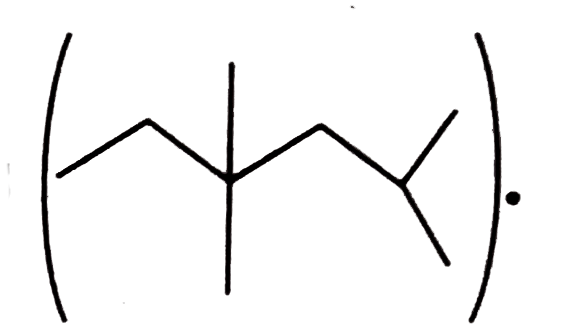The number of 1∘,2∘, and 3∘H atoms in 3-ethy1-5-methy1 heptane, respectively , is:
12,8,1
14,4,2
12,6,2
12,8,2
The correct Answer is:D
To determine the number of primary (1°), secondary (2°), and tertiary (3°) hydrogen atoms in 3-ethyl-5-methylheptane, we will follow these steps:
Step 1: Understand the Structure of the Compound
3-ethyl-5-methylheptane is an alkane with a seven-carbon chain (heptane) and two substituents: an ethyl group at the third carbon and a methyl group at the fifth carbon.
Step 2: Draw the Structure
1. Start by drawing a straight chain of 7 carbon atoms (heptane):
C1−C2−C3−C4−C5−C6−C7
2. Add the ethyl group (C2H5) at the third carbon (C3):
C1−C2−C3(C2H5)−C4−C5−C6−C7
3. Add the methyl group (CH3) at the fifth carbon (C5):
C1−C2−C3(C2H5)−C4−C5(CH3)−C6−C7
Step 3: Determine the Degree of Each Carbon
- Primary Carbons (1°): Carbons attached to one other carbon.
- Secondary Carbons (2°): Carbons attached to two other carbons.
- Tertiary Carbons (3°): Carbons attached to three other carbons.
Step 4: Identify Each Carbon in the Structure
- C1: Primary (attached to C2)
- C2: Secondary (attached to C1 and C3)
- C3: Tertiary (attached to C2, C4, and the ethyl group)
- C4: Secondary (attached to C3 and C5)
- C5: Tertiary (attached to C4, C6, and the methyl group)
- C6: Primary (attached to C5 and C7)
- C7: Primary (attached to C6)
Step 5: Count the Hydrogen Atoms
- Primary Hydrogens (1°):
- C1: 3 H
- C6: 3 H
- C7: 3 H
- Total = 3 + 3 + 3 = 9 H
- Secondary Hydrogens (2°):
- C2: 2 H
- C4: 2 H
- Total = 2 + 2 = 4 H
- Tertiary Hydrogens (3°):
- C3: 1 H
- C5: 1 H
- Total = 1 + 1 = 2 H
Final Count
- Primary Hydrogens: 9
- Secondary Hydrogens: 4
- Tertiary Hydrogens: 2
Conclusion
The number of 1°, 2°, and 3° hydrogen atoms in 3-ethyl-5-methylheptane is 9, 4, and 2, respectively.
3-ethyl-5-methylheptane is an alkane with a seven-carbon chain (heptane) and two substituents: an ethyl group at the third carbon and a methyl group at the fifth carbon.
1. Start by drawing a straight chain of 7 carbon atoms (heptane):
C1−C2−C3−C4−C5−C6−C7
2. Add the ethyl group (C2H5) at the third carbon (C3):
C1−C2−C3(C2H5)−C4−C5−C6−C7
3. Add the methyl group (CH3) at the fifth carbon (C5):
C1−C2−C3(C2H5)−C4−C5(CH3)−C6−C7
- Primary Carbons (1°): Carbons attached to one other carbon.
- Secondary Carbons (2°): Carbons attached to two other carbons.
- Tertiary Carbons (3°): Carbons attached to three other carbons.
- C1: Primary (attached to C2)
- C2: Secondary (attached to C1 and C3)
- C3: Tertiary (attached to C2, C4, and the ethyl group)
- C4: Secondary (attached to C3 and C5)
- C5: Tertiary (attached to C4, C6, and the methyl group)
- C6: Primary (attached to C5 and C7)
- C7: Primary (attached to C6)
- Primary Hydrogens (1°):
- C1: 3 H
- C6: 3 H
- C7: 3 H
- Total = 3 + 3 + 3 = 9 H
- C2: 2 H
- C4: 2 H
- Total = 2 + 2 = 4 H
- C3: 1 H
- C5: 1 H
- Total = 1 + 1 = 2 H
- Primary Hydrogens: 9
- Secondary Hydrogens: 4
- Tertiary Hydrogens: 2
The number of 1°, 2°, and 3° hydrogen atoms in 3-ethyl-5-methylheptane is 9, 4, and 2, respectively.
Topper's Solved these Questions
- CLASSIFICATION AND NOMENCLATURE OF ORGANIC COMPOUNDSBOOK - CENGAGE CHEMISTRY ENGLISHCHAPTER - CLASSIFICATION AND NOMENCLATURE OF ORGANIC COMPOUNDSEXERCISE - Assertion-Reasoning Type
5 Videos
- CLASSIFICATION AND NOMENCLATURE OF ORGANIC COMPOUNDSBOOK - CENGAGE CHEMISTRY ENGLISHCHAPTER - CLASSIFICATION AND NOMENCLATURE OF ORGANIC COMPOUNDSEXERCISE - Fill in the Blanks Type
5 Videos
- CLASSIFICATION AND NOMENCLATURE OF ORGANIC COMPOUNDSBOOK - CENGAGE CHEMISTRY ENGLISHCHAPTER - CLASSIFICATION AND NOMENCLATURE OF ORGANIC COMPOUNDSEXERCISE - Multiple corrcct Answers Types
11 Videos
- CHEMICAL EQUILIBRIUMBOOK - CENGAGE CHEMISTRY ENGLISHCHAPTER - CHEMICAL EQUILIBRIUMEXERCISE - Subjective type
1 Videos
- GENERAL ORGANIC CHEMISTRYBOOK - CENGAGE CHEMISTRY ENGLISHCHAPTER - GENERAL ORGANIC CHEMISTRYEXERCISE - Analytical and Descriptive
1 Videos
Similar Questions
The number of 1∘,2∘, and 3∘H atoms in 2,5,6-trimethy1 octane, respectively,is
View SolutionNumber of 1∘,2∘,3∘ and 4∘C present in compound are
respectively

View Solution(a) Write the IUPAC name of the compound (A) whose bond line structre is

(b) Write the condensed formula of the compound (A).
(c) Define and identify all the primary (1∘), secondary (2∘), tertiary (3∘), and quaternary (4∘) carbon atoms.
(d) Identify all the 1∘,2∘, and 3∘ H atoms.
(e) Given the number of H atoms bonded to 1∘,2∘,3∘, and 4∘ C atom in an alkane.
(f) Given the number of C atoms bonded to 1∘,2∘,3∘, and 4∘ C atoms bonded to 1∘,2∘,3∘, and 4∘ C atom in an alkane.
View SolutionIn the structure of 4-Isoropyl-2,4,5-trimethylheptane, number of 1∘,2∘ & 3∘H's are respectively.
View SolutionIf Ca3(PO4)2andH3PO3 contain same number of 'P' atom then the ratio of oxygen atoms in these compounds respectively is
View SolutionWhat is the decreasing order of basicity of 1∘2∘ and 3∘ ethy1 amines and ammonia ?
View SolutionIn 2-Chloro-3-methy1 hexanoic acid, the primary suffix is:
View Solutiona. A hydrocarbon contains all the three tyopes of H atoms, i.e., 1∘,2∘ , and 3∘ . The relative ratios of abstraction of …………………… H atoms are 5.0:3.8:1.0 .
c. The relative rate of abstraction of 3∘,2∘ , and 1∘ H atoms is maximum for ................... H atoms.
d. The relative rate of abstraction of 3∘,2∘ , and 1∘ H atoms is minimum for ................. H atoms.
View SolutionCalculate the energy released in joules and MeV in the following nuclear reaction:
.1H2+.1H2→.2He3+.0n1
Assume that the masses of .1H2, .2He3, and neutron (n), respectively, are 2.40, 3.0160, and 1.0087 in amu.
View SolutionIn the alkane H3C−CH2−C(CH3)2−CH2−CH(CH3)2, identify 1∘,2∘,3∘, carbon atoms and give the number of H atoms bonded to each one of these.
View Solution
